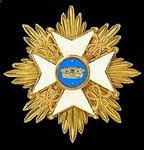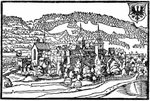First raised 1677 under Louis XIV. Originally a Walloon regiment. Incorporated the regiment Fleury in 1749. 2 battalions in 1756. Ranked 64th in 1753. [Names in capitals below are the names of the regiment as its ownership changed]
The evidence suggests this pattern of flags was carried at least from 1697 when the regiment was ISENGHIEN to 1762 under ROHAN-ROCHEFORT.
Service history [from Susane Volume 8 with corrections from Kronoskaf]:
Raised 22nd February 1677 by N. de PIETTEMONT
1677: Battle of Kassel; the colonel is killed there
1677: Given the 1st November to Ignace de Belvalet, Count of FAMECHON
1678: Army of Catalonia; capture of Puycerda
1688-1689: Served on the river Bidassoa [a river on the SW boundary of France with Spain]
1690: Expedition to Ireland; battle of the Boyne; defence of Limerick
1691: Re-entered France and sent to Italy
1693: Battle of Marsaglia
1694: Army of Catalonia again: battle of Ter; capture of Palamos, Girona, Hostalrich and Castelfollit
1695-1696: Army of Italy again
1697: Given the 11th February to Louis de Gand-Vilain de Mérode de Montmorency, Prince of ISENGHIEN
1701: Army of Flanders
1702: Combat of Nimègue
1703: Army of the Rhine; siege of Kehl; combat of Munderkirchen; 1st battle of Hochstedt
1704: 2nd battle of Hochstedt [Blenheim]
1705-1706: Army of the Rhine
1707: Army of Flanders
1708: Battle of Oudenarde
1708-1714: In garrison at Valenciennes
1717: Given to the Marquis de MONTESQUIOU then Victor-Alexandre, Marquis de MAILLY
1733: Army of Germany; siege of Kehl
1734: Siege of Philipsbourg
1735: Combat of Klausen
1735: 7th March given to the Marquis de BIRON
1741: Army of Westphalia
1742: To Bohemia; retreat to Prague
1743 Battle of Dettingen
1744: Army of Flanders; capture of Ypres, of Menin and Furnes
1745: Siege of Tournai; battle of Fontenoy; capture of Oudenarde, Termonde and Ath
1745: 1st December given to Charles-Armand-Jules, Prince of ROHAN-ROCHEFORT
1746: Siege of Namur; battle of Rocoux
1747: Conquest of Dutch Flanders; battle of Lawfeld
1748: Siege of Maastricht
1756: Expedition to Minorca
1757: Army of Germany
1758: Battles of Krefeld and Lutzelberg
1759: Capture of Frankfurt
1760: Combats of Warburg and Klostercamps
1761: 26th February given to Charles-Emmanuel, Chevalier de SAINT-MAURIS
1762: 10th December incorporated into Regiment Poitou
And this was the uniform in 1756:




















A wonderful set of flags and uniform David, thanks for sharing.
ReplyDeleteWillz.
Thank you, Willz! :-) You stand out as the only person to comment so far so thanks for sticking with it; I did rather suspect these flags might not be terribly appealing! Not every flag can be stand out attractive, can it? ;-)
DeleteAll the best,
David.
It may not have the 'bling' of other flags, but it has a nice and understated look to it, which is appealing in its own right:).
DeleteThank you, Steve. Sorry, I have only just found this message of yours buried in the Spam list! I agree that flags that are understated do often have a charm of their own! (They are also much easier for me to create, definitely a bonus from my point of view! ;-))
DeleteAll the best,
David.
Hi David. Very nice work indeed. I've an interest in this regiment (as I do in all of those which participated at Fontenoy in 1745). At that time this regiment was known as 'Biron', and held the line between Fontenoy and Antoin villages.
ReplyDeleteFlag colours are truly a conundrum! Kronoskaf has the regimental flag as having black and 'orange' cantons, whereas Susane has them described as black and 'isabelle' (or isabelline). Apparently this colour can be 'pale grey-yellow, pale fawn, pale cream-brown or parchment colour'. I've gone with Susane's description, with the result being a duller, less appealing flag, colour-wise!
Thank you, Doug. :-) Sorry to be slow replying; somehow missed your comment when it first appeared. I get a bit distracted by "real life" sometimes! Charrié cites Isabelle for the flags too; but inevitably the colour of Isabelle is open to much interpretation, as you say. No doubt flags also changed colour in use as the dyes changed with sun bleaching and so on. That does give us some latitude, fortunately. :-)
DeleteAll the best (and a Happy New Year),
David.
I think they are a pretty cool set of flags, I will be making this regiment.
ReplyDeleteWillz.
Thank you, Willz. :-) I look forward to seeing them in action with your troops at some point. The regiment certainly saw a lot of action, especially in the earlier 18th century...
DeleteAll the best (and a Happy New Year),
David.